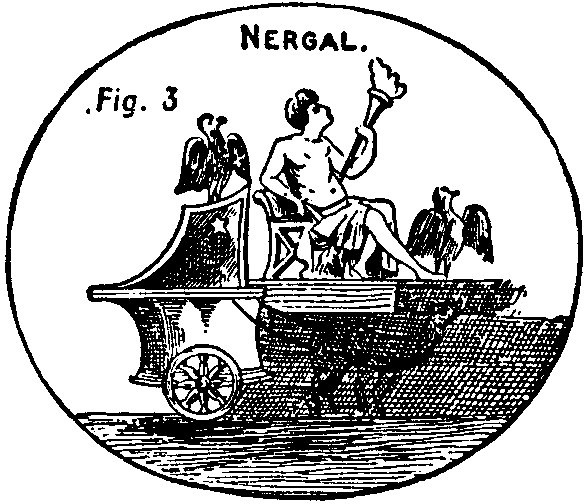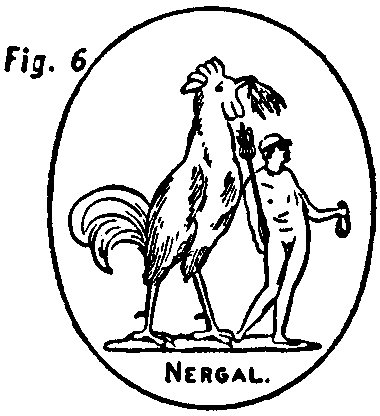
THE NERGALS FROM CUTHA

IN a work that is considered spurious by most these days, "The Sixth and Seventh Books of Moses", we are given an interesting narrative that we find in no other place. It is not an entirely spurious legend, to be left with the other fictions of our past, as a lot of people tend to do today, out of vanity and smugness. No, it has historical relevance, since there are elements to the story which may actually be true.
At the time the Northern Kingdom fell to the Assyrians, circa 723 B.C.E., migrants were shipped west from Mesopotamia, in what we refer to as the Samaritan Exchange program. They were brought west in order to replace the Israelite inhabitants, in a move that resembled the westward expansion in the United States, some 2500 years later.
It is said that a specific race of these immigrants were known as Cuthans, since they migrated from Cutha. These Cuthans were priest-magicians sent to teach their fellow countrymen the customs, religious observances and laws of the place they were moving to. The text we are referring to says, from the subhead entitled "The Vestibule of the Entrance" -
"The language and manuscript of this rare and eternal monument of light, and of a higher wisdom, are borrowed from the Cuthans, a tribe of the Samaritans, who were called Cuthim in the Chaldee dialect according to the Talmud, and they were so called in a spirit of derision. They were termed sorcerers, because they taught in Cutha, their original place of abode, and afterward, in Samaria, the Kabala or Higher Magic (Book of Kings). Caspar, Melchior, and Balthasar, the chosen arch-priests, are shining lights among the eastern Magicians. They were both kings and teachers - the first Priest-teachers of this glorious knowledge, and from these Samaritan Cuthans - from these omnipotent priests of the fountain of light, who were called Nergal, according to the traditions of Talmud, originated the Gypsies, who, through degeneracy, lost the consecration of their primordial power." - The Sixth and Seventh Books of Moses, p. 82.
There may be elements of truth to this narrative, as we said, because the Encyclopaedia Britannica (14th Edition) tells us, regarding the Assyrian conquest of Samaria:
"The operation was completed by Sargon, who deported its inhabitants and substituted for them a new body of settlers from Cutha, according to Jewish tradition, the ancestors of the Samaritans."
This refers to a period prior to the Samaritan Exchange program, undoubtedly, but the pattern is there. Another source, the Encyclopaedia Judaica, in an article on al-Dustan [Dositheos], states that:
"...a Dostai and a Sabbai are mentioned in the Midrash as the priests sent by the Assyrian king to Samaria to teach the new settlers the laws and customs of the country. In a legend told by Josephus about a religious dispute between Jews and Samaritans before Ptolemy IV Philometer, Samaritan representatives are called Sabbeus and Theodosius (Theodosius being another form of Dositheos)."
The Harranians transmitted their teachings to the West, at a time just prior to the First Crusade. They (or their heirs) ended up in Constantinople, and the first result was the Brothers of the East, 1080 / 1090 (depending on time line). From there it made its way Westward, and both the Rosicrucian Current and the Fratres Lucis Current sprang up as a result and perpetuated themselves sometimes in tandem, sometimes separately, and both currents exist in some form or another, to this very day, though not necessarily in the groups which claim these traditions for themselves.

[NOTE - The Map for this material is accessible HERE]
What we are setting forth is the migration of specific groups to specific locations that bear heavily on the History of the Authentic Tradition. Enumerated below, we have a listing of groups / locations / dates:
Before 14th Century B. C. E., a migration of Priests from India to Ethiopia, via Arabia.
A significant event in the history of this group and its successors, is the reign of Akhnaten.
14th - 11th Centuries B. C. E., Serpent Cult of Euboea, some go to Athens, settle there, and create a Mystery School. This becomes the basis for the Dionysian Artificers. The Dionysian Artificers really existed, as archaeology has been discovering.
From Athens, representatives of this school travelled to Ionia.
From Ionia, to Phoenicia and from there to Israel.
It is known that the Phoenician and Ugaritic traditions had a profound influence on both the Greeks and the Israelites.
8th Century B C E... Nergals of Cutha to Samaria. The First Dositheos alive at this time.
6th Century B C E (circa 540)... Ophites at Opis, on the Tigris, migrate to Phrygia / Mysia / Pergamos.
Sabbeus and Theodosius in Samaria, circa late 3rd Century B. C. E.
133 B C E, Pergamos becomes a strong seat in the Roman Empire.
Ophites / Naassenes, in Pergamos, establish a cult.
They Migrate to Samaria, where it takes hold first.
Essenes at Dead Sea and Damascus.
After 68 C. E., most of these schools that were in Judea and related areas, move on to the Transjordan and to the Decapolis regions.
Gnostic Succession (Dositheos to Bar Daisan)
Ebionite and Elkesaite Succession (including first Church of Believers, Nazaraeans, Nasoreans, Nazarenes, Nosrei Ha Berit, Sampsaeans, etc.) . Eventually, some of these form the original Church (post-first family, that is, and rivals to the Pauline heresy). Some of these, such as the Sampsaeans, include members of the family bloodline, the desposynii, and they move on to Kurdistan. Some of these become a part of the Mandaean tradition. Some of these become a part of the Catharist Gnosis, eventually.
The Daisaniyya of Edessa (Bardesanites), eventually bring us two important groups: The Batiniyya of Abdallah ibn Maymun, and the Yezidis. The latter were also influenced by the Sampsaeans (who had the cult of Shams, the Sun); and they were influenced by native cults, in Kurdistan; the Ashokhs. The later founder of the Yezidis (really the reformer of a much older cult), Sheikh 'Adi, came from Druze territory in the vicinity of Ba'albek. The Druzes in their turn, included native elements, but also included inspiration from the Nusairi, who go back to the original Keepers of the Covenant, the Nozrei-ha-Berit.
Ophite Migrations, to the 8th Century C. E. Particularly in Mesopotamia, Syria, and Kurdistan.
Harranian Pagans, Yezidis, Sufis, Isma'ili.
Rose+Croix Veritas. Contrary to those who continue to stubbornly believe that the Rosicrucians only go back to Andrea and his propaganda campaign, the R+C actually goes back to Ormus, the Seraphic Priest, who was converted to Christianity by Saint Mark, and fused the Mysteries with Christianity, thereby creating a school of Solomonic Wisdom. He mailed us a photocopy of his charter, just the other day. In reality, the concept of the Cross goes back to ancient Sumer, and beyond that, even, to the place of origins.
But, for more recent considerations, we shall place the Rose+Croix at Constantinople, in the form known as the Brothers of the East (Orient). This group, according to R. Ambelain, was established at that fine city, around 1080 c.e. We know precious little about the Brothers of the East (Orient). 1188 is the year that is considered important in the history of the Authentic Tradition, with respect to the splitting up of the Original Templar Order and the Order of Sion. It may be. The Temple goes back to both 1118 and 1188.
According to the Legend of the Strict Observance, though, some more data is to be found. Evidently Andre de Montbard was an important character. Although there are those who believe that these stories never took place, it is said that Andre de Montbard, third Prior of the Chanoines, established a perfect union between the Syrians and the Chanoines. The Syrians were seven Syrian Christians at Bostra, or Bosra, Syria. They were surviving Essenes, pursued by the Infidels in that former Nabatean community. In exchange, the Mysteries were communicated to Andre de Montbard and the Chanoines. Andre de Montbard was Saint Bernard's Uncle. This is an important story.
From this point on, we can go back to the Chronology we put together in the section on the Harranians, The City of Sin.
Basically, though, from Marsilio Ficino to the present day is the next increment in the chart.